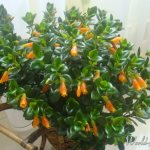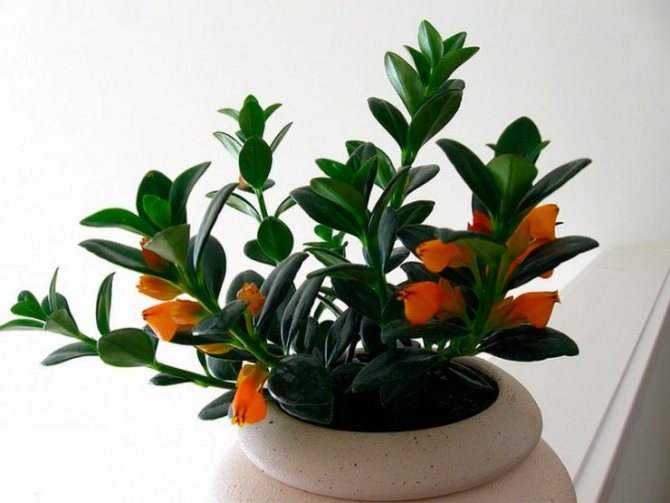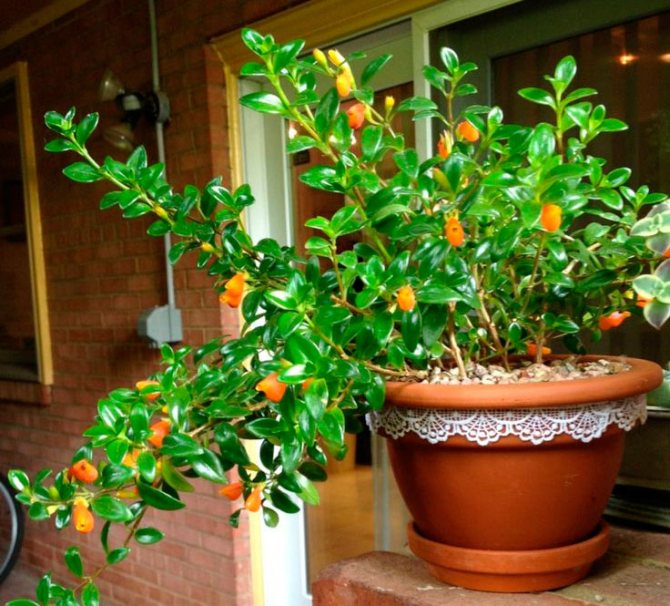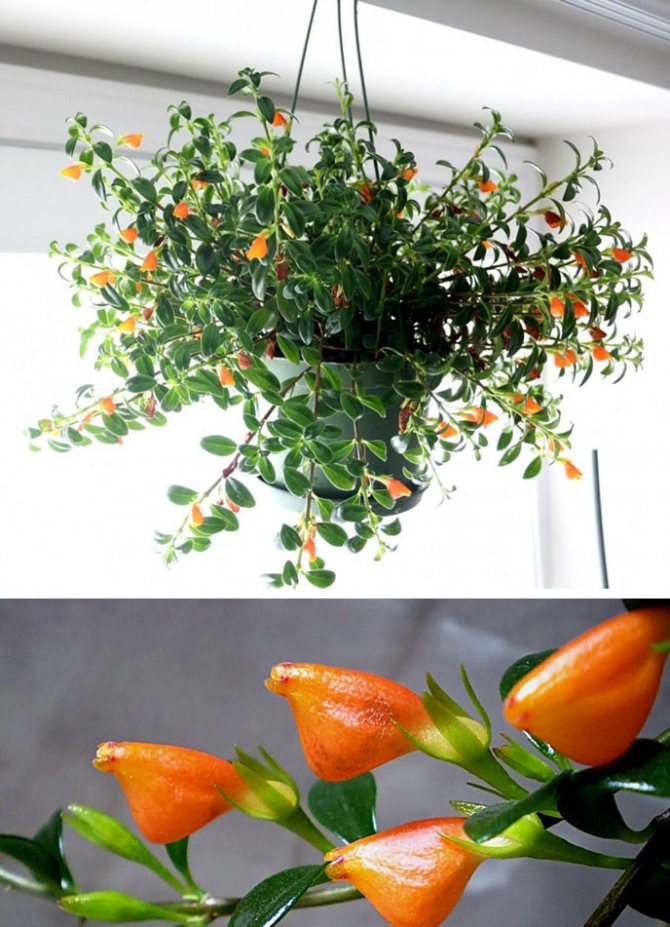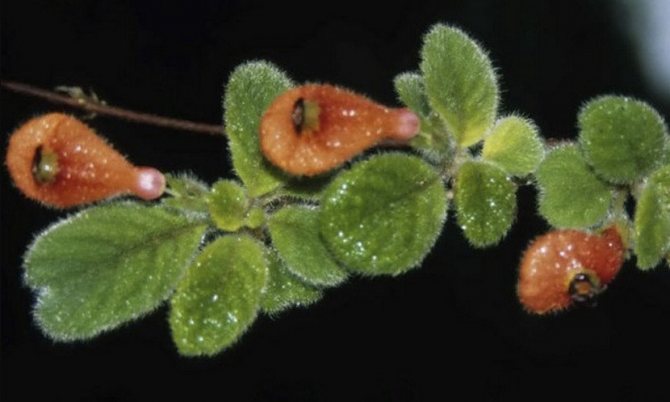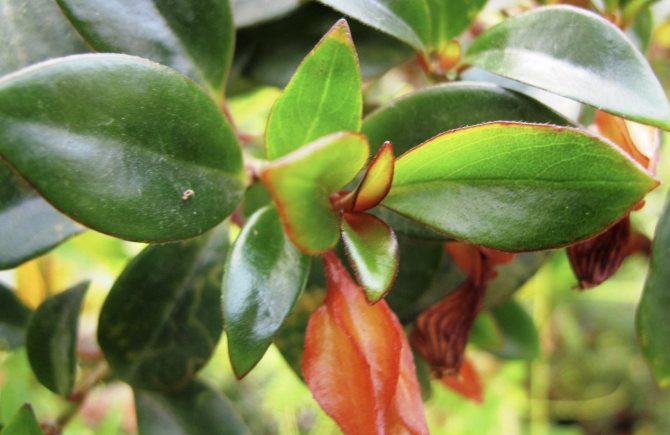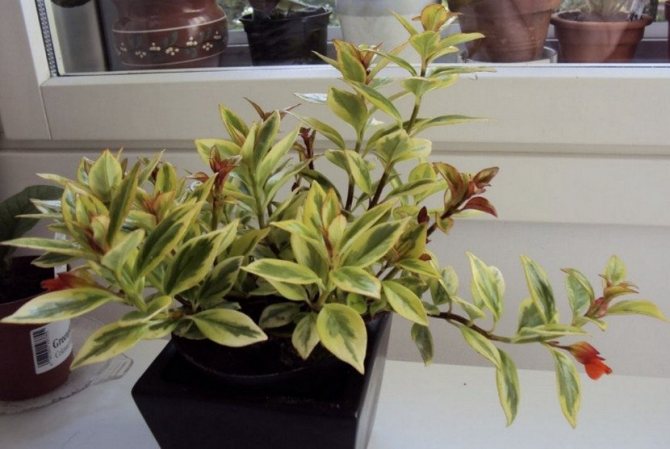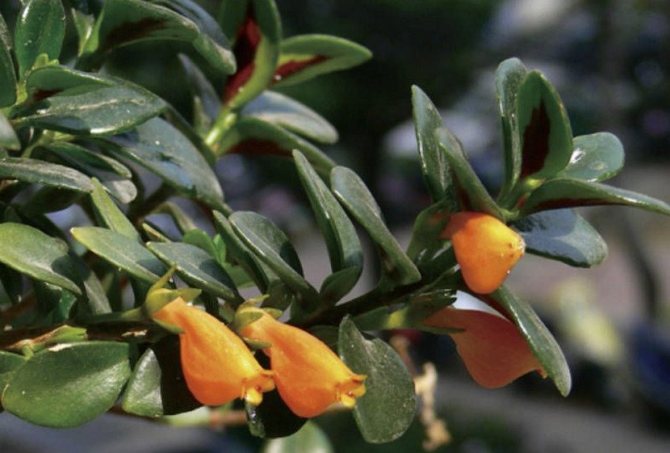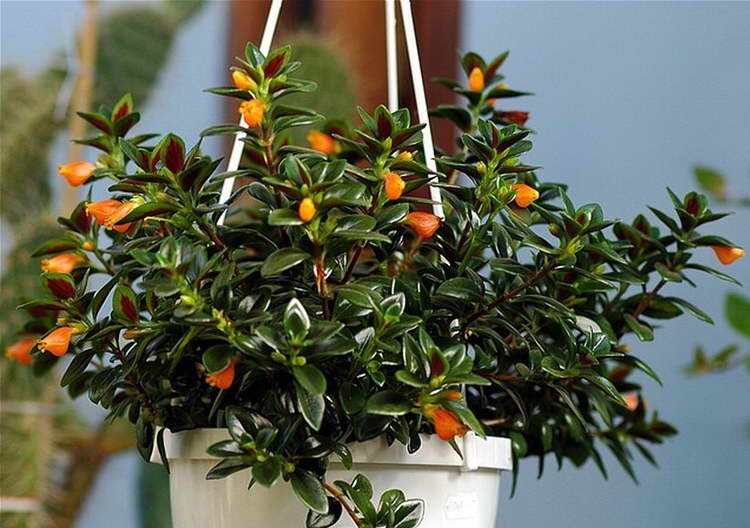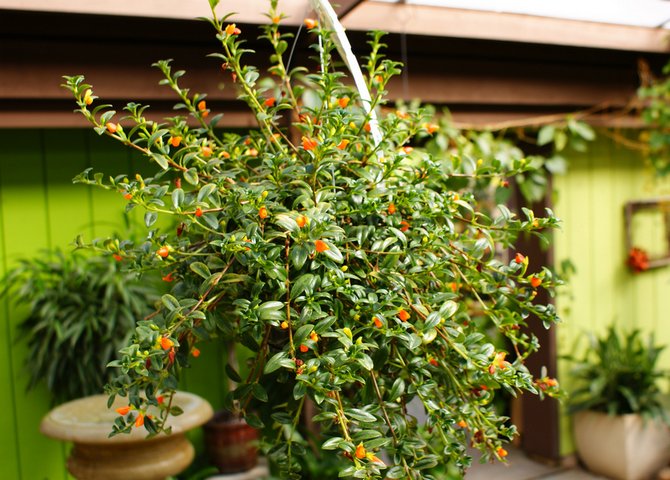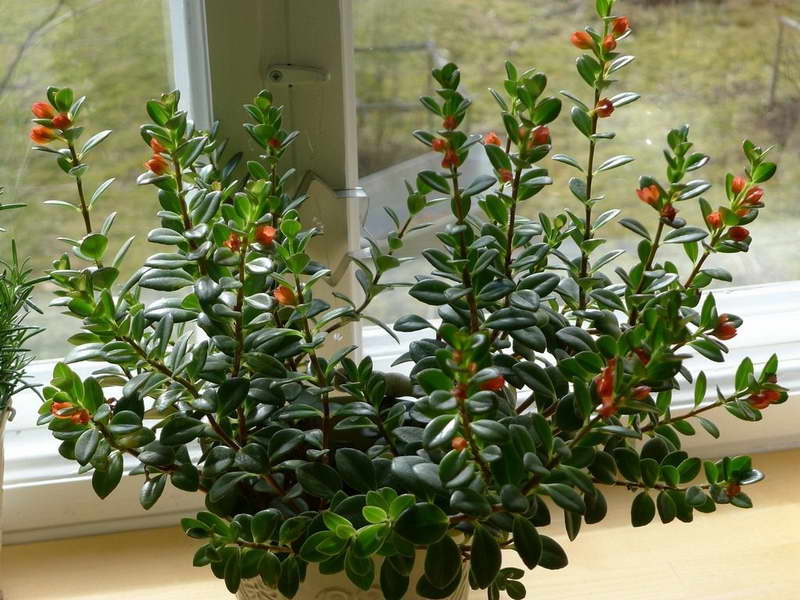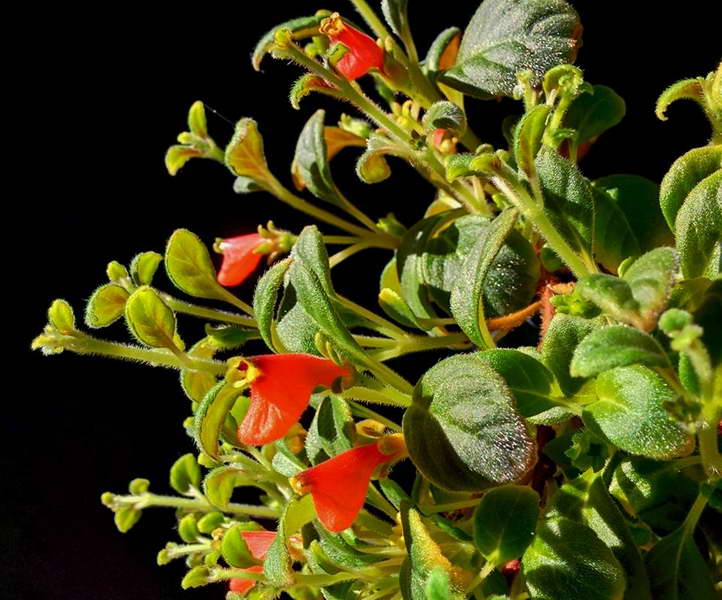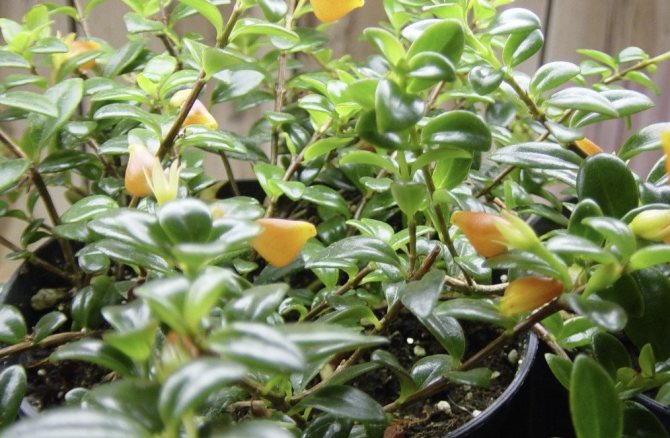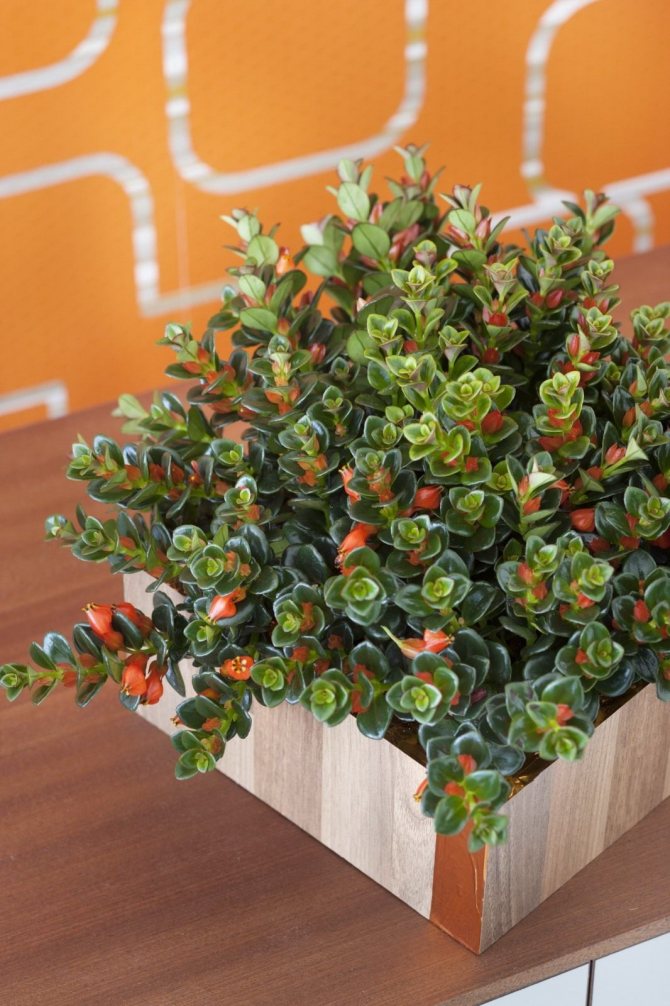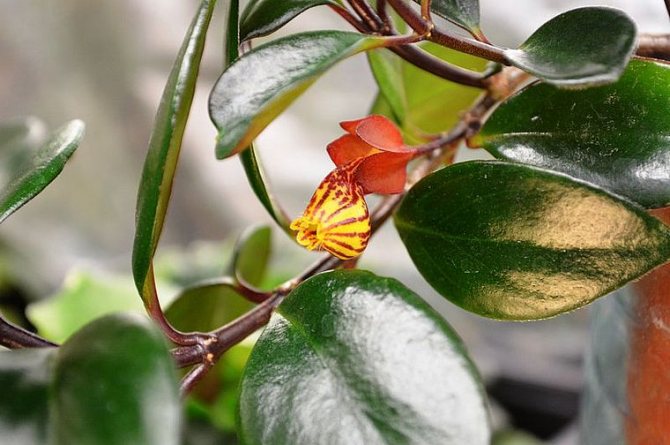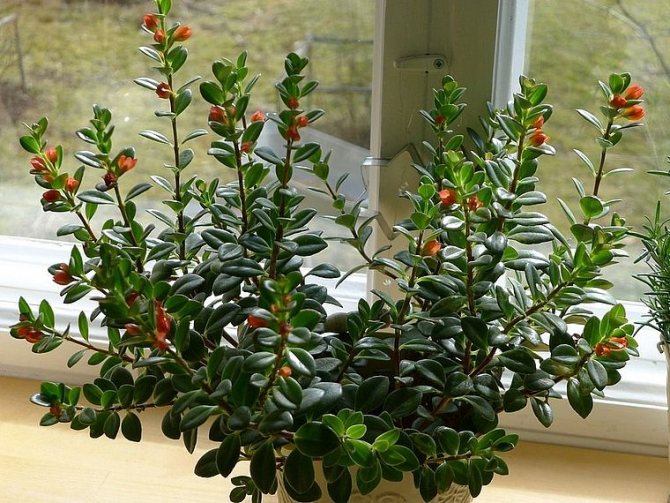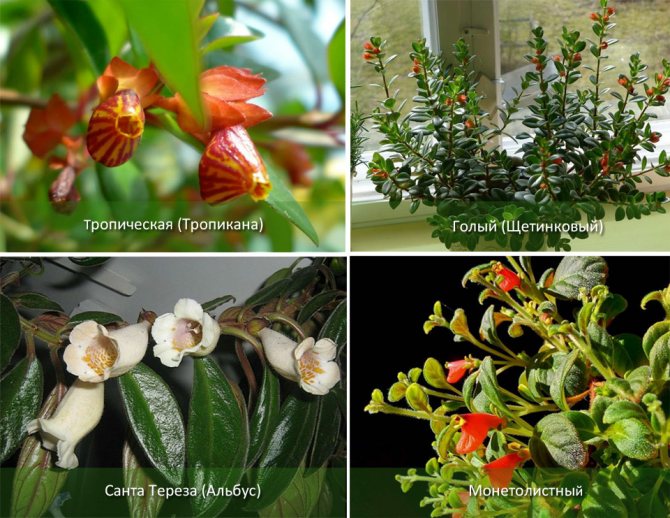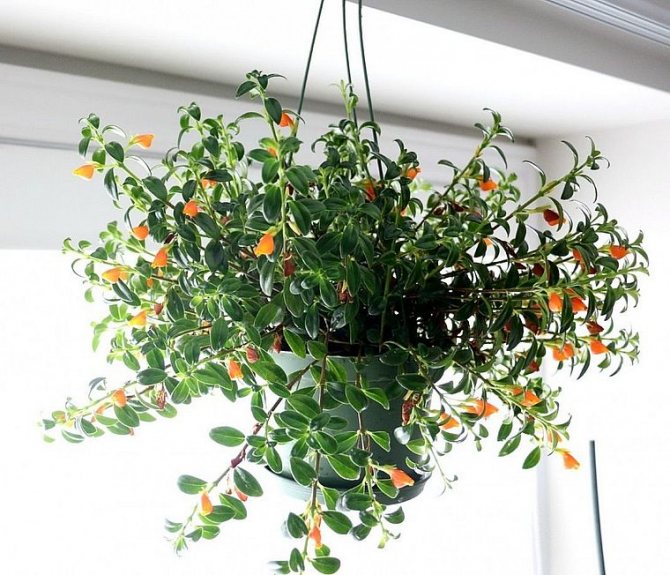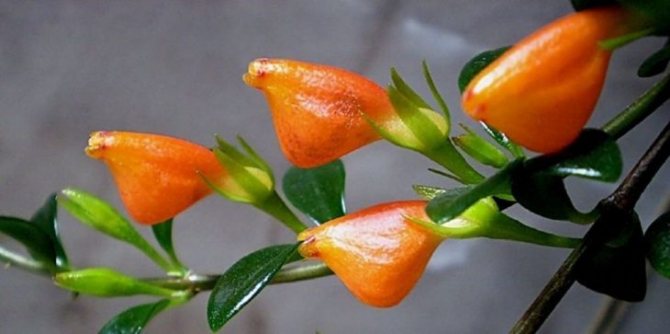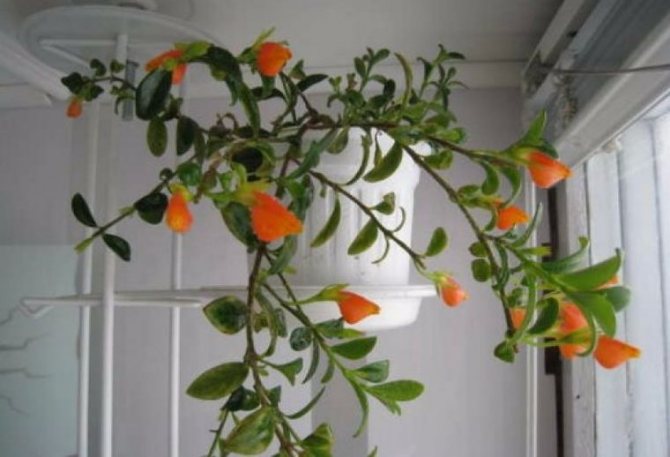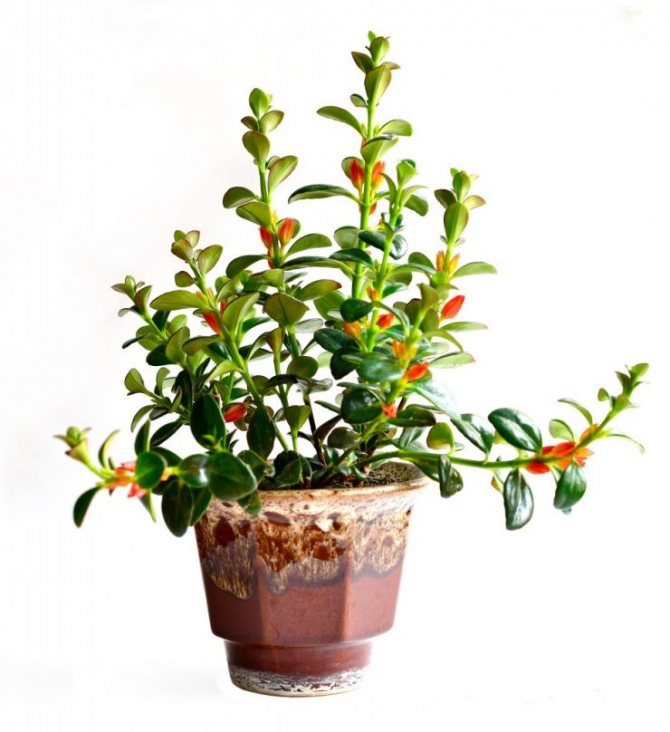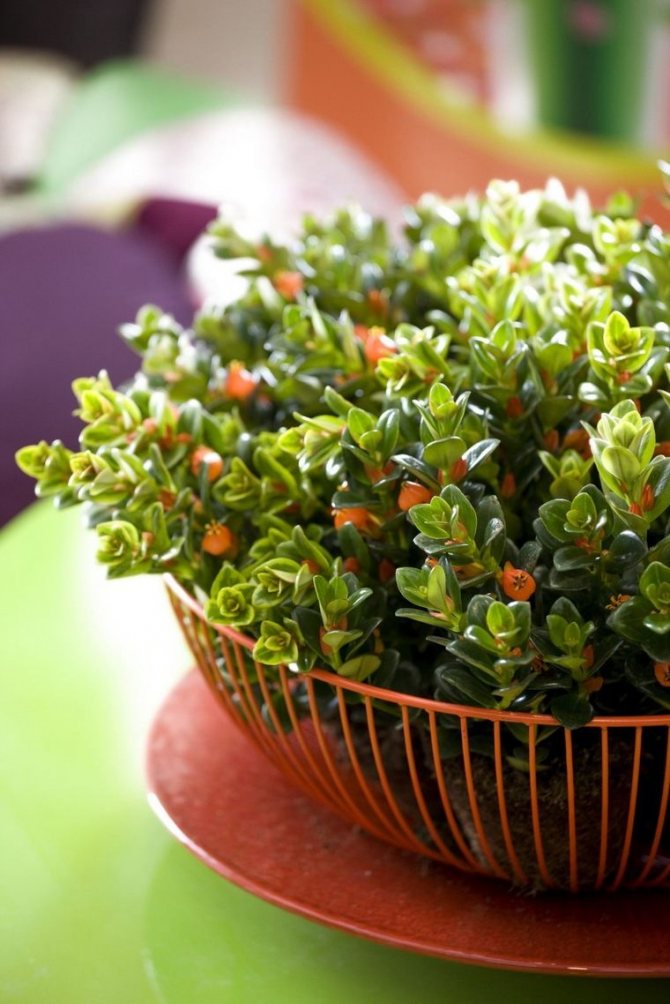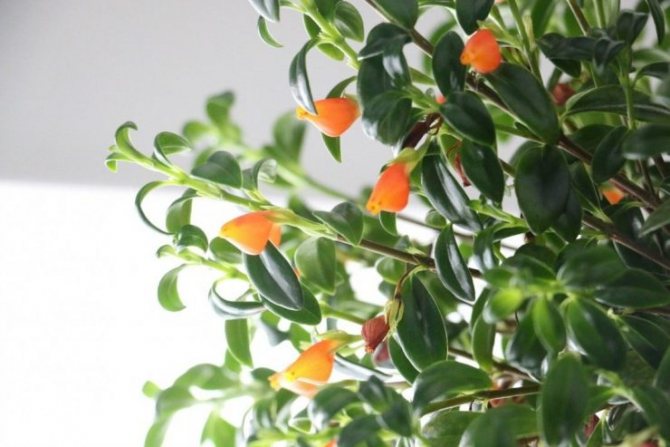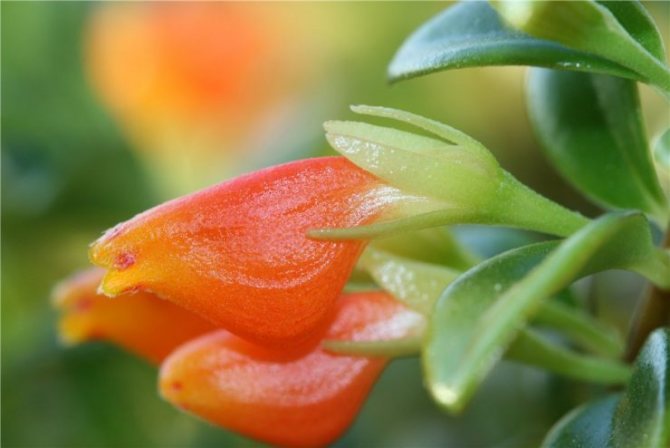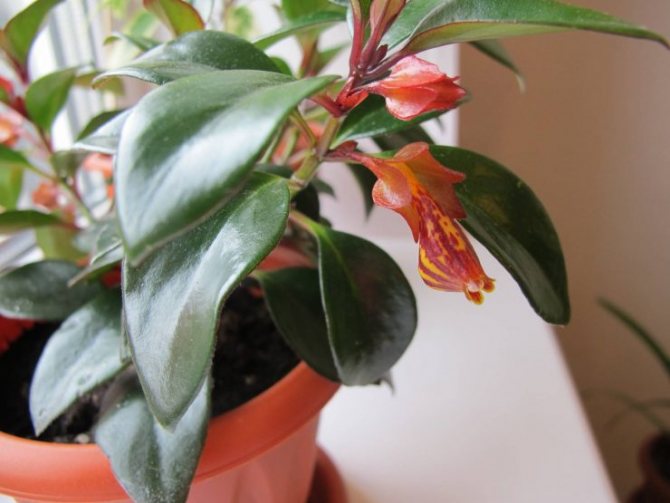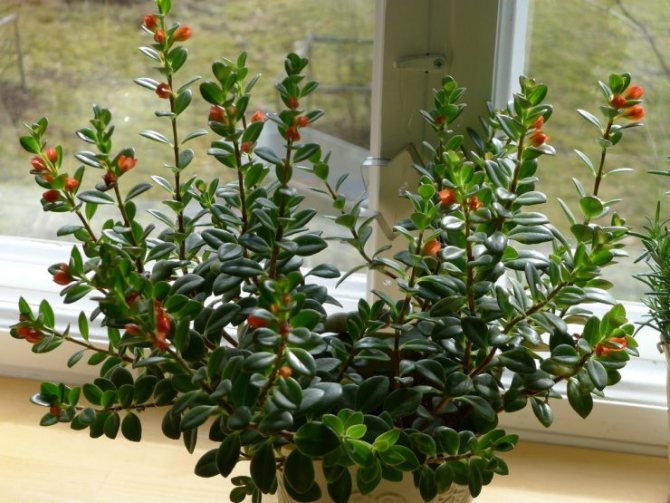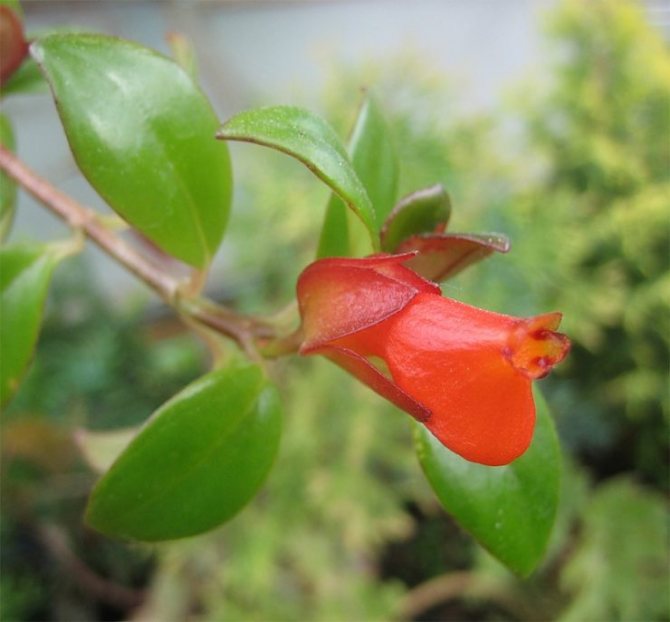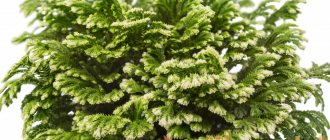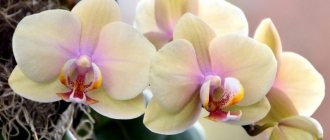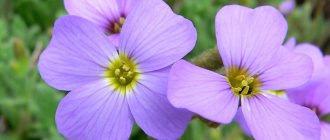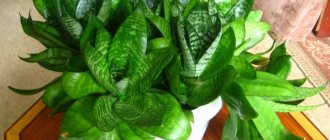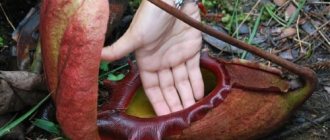Nematanthus belongs to the Gesneriaceae family. Under natural conditions, it is a semi-shrub or herbaceous plant growing or permanently attached to other plants (epiphyte). The genus includes about 30 species. The homeland of the nematanthus is South America. According to the modern classification, the once independent genus Hypocyrt entered it.
Blooming nematanthus on the windowsill
Appearance
Nematanthus flower grows in the Amazon forests, which are characterized by high humidity. The leaves of the plant are dark green, in the form of an egg or ellipse, sometimes they have streaks of a bluish tint. The length of the specimen is from 30 to 100 mm. The underside of the leaves is soft, may have a purple tint.
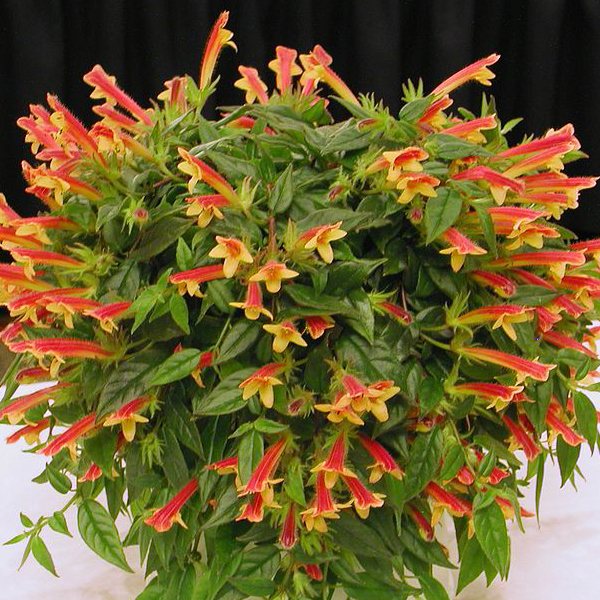
Nematantus - South American exotic flower
Nematanthus gregarius has unusual flowers. There are several types of plants, each of which is different in the color of the buds. It blooms in the jungle only in summer. At home, flowering time can last from March to November.
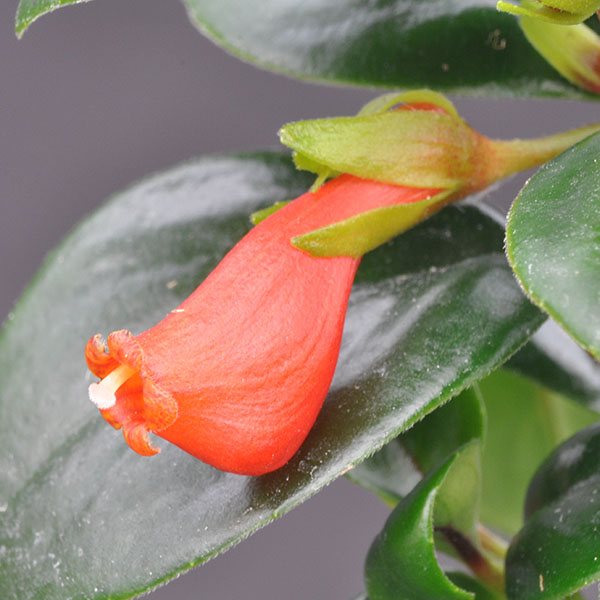

The flowers of the plant are like aquarium fish.
Important! A sign is associated with the plant. It is believed that joy and well-being will always be present in the house where it blooms.
Diseases and pests
Powdery mildew or gray rot can affect hypocyrtu if the optimal growing conditions are systematically violated. Too high humidity in the soil and air will have a detrimental effect on the plant. If you notice the first signs of illness, remove unhealthy shoots and leaves and apply a fungicide.
Often, the plant tolerates attacks by aphids, scale insects, whiteflies and spider mites. To save a hypocyrt from them, use ready-made chemicals sold in specialty stores.
Varieties
Oncidium: home care and flower varieties
Nematantus Goldfish has about 35 species. About 7-8 of them are grown at home around the world:
- The most spectacular is Nematanthus Gregarius. It is he who is called the Goldfish. Best for planters. Beautifully flowing vines will appeal to all lovers of the unusual.
- Riverside. The species has large leaves, approximately 10 cm in length. Flowers are lemon yellow. The pharynx is deployed, which is uncharacteristic for most nematanthus.
- View of Wetstine. The leaves are small, oval in shape. Their surface is smooth and waxy. Gives shoots in the form of vines, which can reach a meter. The flowers are tubular, red-orange or yellow, 25 mm long.
- Nematantus Tropicana. It has large flowers in the form of yellow-orange water lilies.
- Santa Teresa is a unique and almost uncommon species. The flowers are up to 50 mm long. Cream or white color predominates. There are yellow spots on the surface.
- Variegated nematanthuses are worth highlighting separately. Their occurrence is due to genetic mutations due to insufficient production of chlorophyll by the leaves. Hybrid nematantus looks unusually beautiful.
- Nematantus Golden West. It has thick leaves with a creamy yellow canvas. The shade of flowers is red-orange.
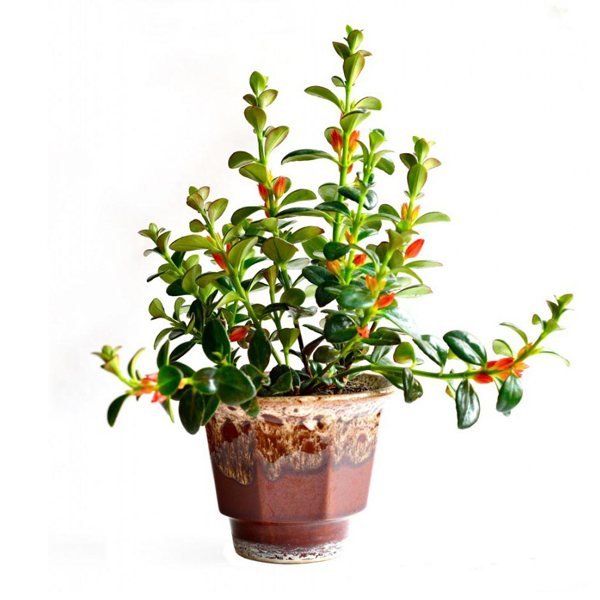

Nematantus Tropicana is a beautiful plant
There are other types of Nematanthus. They all differ in the shape of the leaves and the shade of the flowers.
general description
Shoots of nematanthus are climbing, creeping or hanging, up to 90 cm long.They first grow vertically, then lower under their own weight. Its leaves are small, juicy, elongated with a sharp tip, painted green; in some species, the underside of the leaf plate is purple.
For the unusual shape of flowers with intergrown sepals, nematanthus is sometimes called a "goldfish". The corollas of the plant are colored orange, pink, red, purple. Abundant flowering, long lasting, lasts all summer.
Nematanthus is considered both an ornamental-leafy and ornamental flowering plant.
Care features
Types of flower zephyranthes - home care
The plant will not exist by itself. Care must be taken for nematanthus. You will have to take into account everything: feeding, watering, lighting. It is not difficult to create the required conditions, but they are constantly maintained.
Temperature
When flowering, the plant should be in a room with a temperature of 19 to 24 degrees. In winter, 17 degrees will be enough, since Gregarius is at rest. Due to excessively high or low temperatures, the plant will begin to die.
Lighting
Ideal for indoor nematanthus flower is bright diffused light. The plant will be comfortable on a windowsill located in the eastern or western part of the room. Due to the lack of light, it will stop blooming. For this reason, the flower is supplemented using a phytolamp.
Watering
When flowering nematanthus gregarius radicans, watering should be regular and abundant. It is cut in winter. Water for irrigation is taken at room temperature. In the case of growing a species with large leaves, delimited watering is provided. If there is not enough water, the leaves curl and fly around.
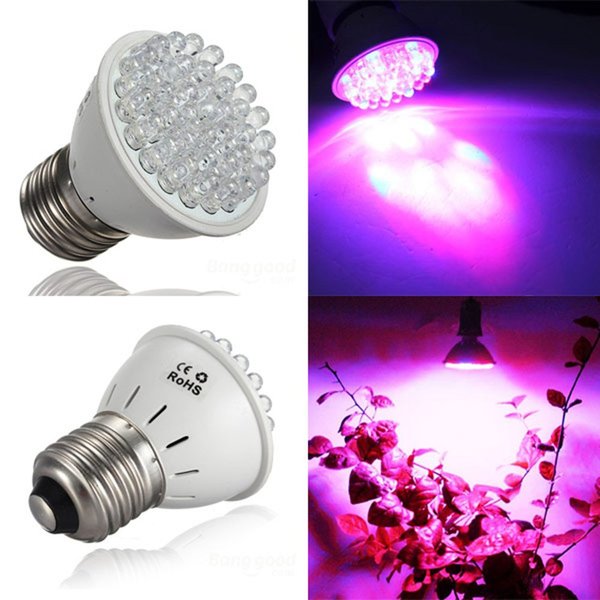

Phytolamp is used for additional lighting.
Spraying
At every season (except winter), the flower needs to be moistened - sprayed. To do this, take warm water. If it gets cold, the bush does not need additional moisture.
Humidity
The optimum room humidity should be 50%. If the temperature in the room is high, then the humidity must also be increased. This nuance must not be overlooked.
Priming
When growing hypocyrtus nematanthus, loose soil is required. Ready-made substrate can be bought in stores. When creating a soil mixture with your own hands, sand, peat and humus are taken in equal doses. For better water flow (drainage), small foam balls, brick chips or vermiculite are added.
Top dressing
To maintain the flowering of the nematanthus plant, additional feeding is necessary. The ideal option is special solutions. These can be purchased at gardening stores.
Important! To prevent chemical burns, fertilizers are added in the evening.
Features of growing at home. Briefly
Nematanthus takes root well at home if it is provided with basic care:
| Temperature regime | In winter - up to + 13 ° C, and in summer - up to + 25 ° C. |
| Air humidity | From 50%, spray regularly. |
| Lighting | Diffused bright light, placed on east-facing windows. |
| Watering | Regular when the top layer of the substrate dries up. |
| Priming | A mixture of equal parts of humus, peat, sand or ready-made soil for Saintpaulias. |
| Top dressing and fertilization | In the spring - in the fall, once every 3 weeks, fertilizer for orchids or a universal mineral agent, diluted in half, is used; do not feed in winter. |
| Nematanthus transplant | They are carried out rarely, in spring or autumn. |
| Reproduction | Cuttings from the tops or seeds. |
| Growing features | In the spring or after the end of flowering, all branches are cut by a third so that the plant rejuvenates, and flowers appear on young shoots. |
Flowering nematanthus
Rhipsalidopsis: home care and plant varieties
For a goldfish flower, home care must be carried out carefully.If you complete all the required actions, it will bloom from mid-May to late September. If kept in suitable conditions, the plant can bloom in winter.


The lower part of the flower looks like exotic berries
The flowers have an extraordinary resemblance to aquarium inhabitants, which is why the plant is called a goldfish. The shade of the flowers can be different: orange, red, yellow. Corolla petals grow together, acquiring a similarity to a pocket. Inside this "pocket" there is a tubular pharynx. The lower part of the flower seems to be swollen, becoming like a fantastic fruit.
Types of home nematanthus with photos and names
There are 35 species of nematanthus in nature. In room culture, only a few of them are common.
Nematanthus monofilament Nematanthus nummularia
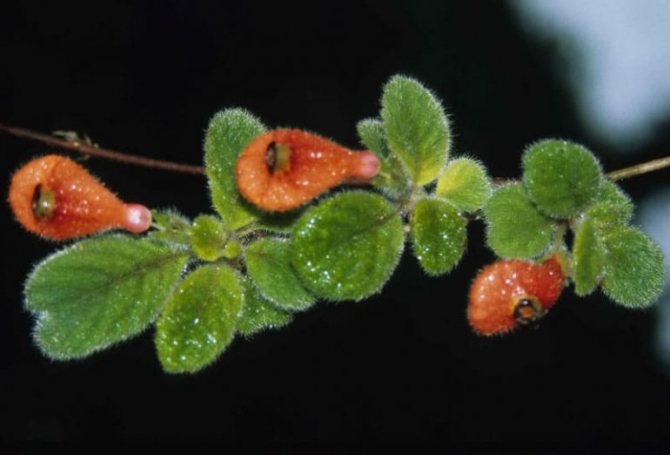

The plant is ampelous. The diameter of light green rounded leaves is up to 20 mm. Small flowers are scarlet with a bend of golden color. After completing flowering, the plant throws off the foliage.
Nematanthus gregarius Nematanthus gregarius
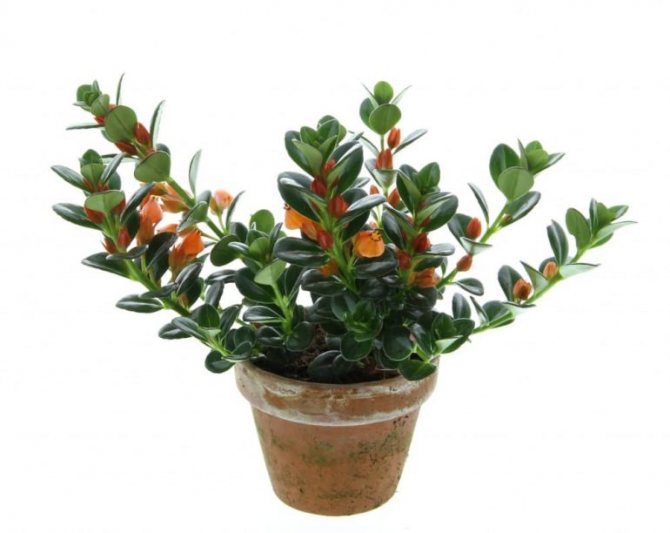

Glossy dark emerald leaves are small. The golden-red flowers look like small fish. This species is called the Goldfish.
Nematanthus glabra
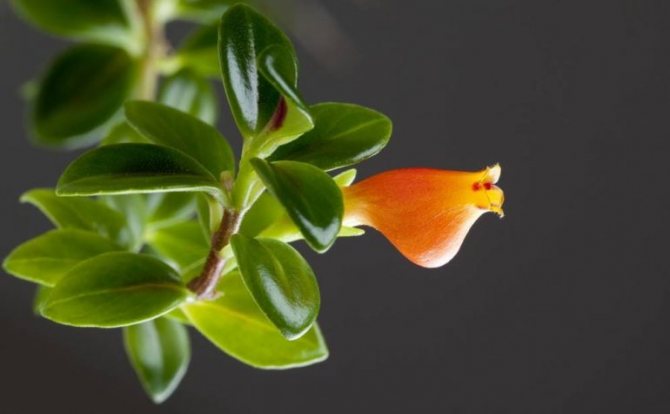

Fleshy bright green leaves are distinguished by their elongation (up to 40 mm) and gloss. In their sinuses, up to 3 bright orange flowers are formed. Semi-ampel plant.
Nematanthus wettsteinii Nematanthus wettsteinii


A plant with branching thin shoots elongated to 0.9 m. Dark green oval leaves are covered with a light waxy bloom. Red-orange flowers are small (up to 2.5 cm) tubular. It is grown as an ampelous plant in a hanging container.
Nematantus diversifies any interior, emphasizes its grace. Maybe the plant will not attract "golden rain", as the popular belief promises, but it will definitely cheer you up with its original appearance.
Reproduction of nematanthus
Plant propagation is possible in two ways:
- Seeds;
- Cuttings.
Growing from seeds
There are some difficulties as the seeds are very small in size. They are carefully distributed over the surface of the soil mixture and sprayed with a spray gun. It is forbidden to cover with earth. After completing the necessary manipulations, cover with a film. Watering should be low and sparse. When a sprout appears, the film is removed. After the formation of three leaves, the plants can be transplanted into separate pots.
Cuttings
In nematanthus, propagation by cuttings is easier than by seeds. It can be carried out in summer and spring. Cuttings 12 cm in size are cut from a long shoot, after which all the leaves in the lower part are removed. The twigs must be rooted in water or moist soil. The sprout is preliminarily treated with a root formation stimulant. Then all the cuttings are immediately planted in one pot. After they take root, pinching is required.
Important! Seed-grown nematanthus will not bloom in the first year.
Nematanthus fritschii
Reaches a height of 65 cm. The fritsch has a beautiful, double-sided leaf color. Green, downy on top and purple-reddish on the underside.
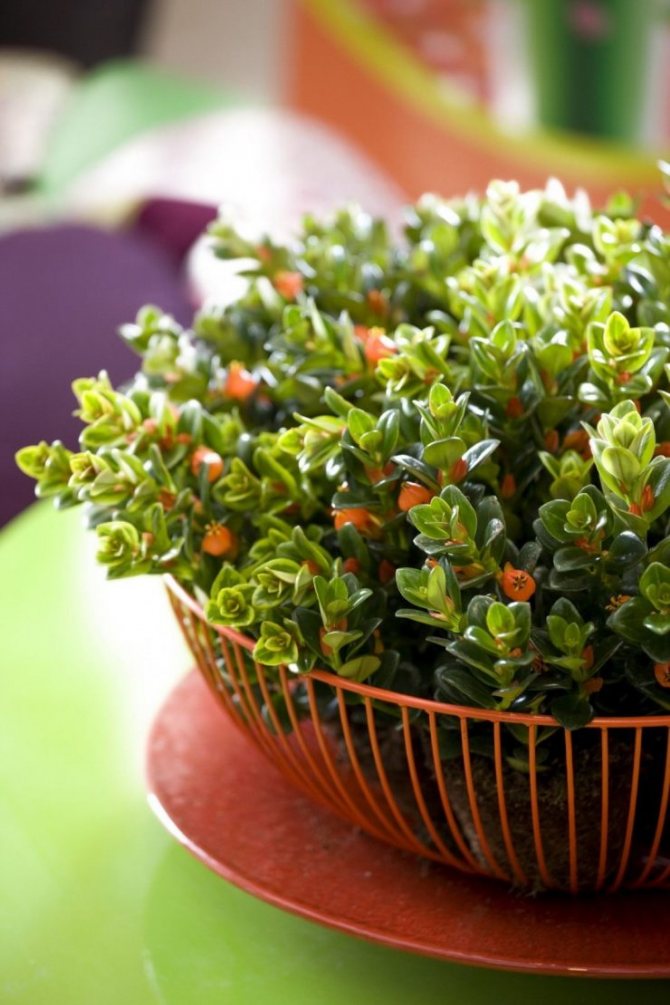

Nematanthus flowers are pink, funnel-shaped, up to 6 cm long.
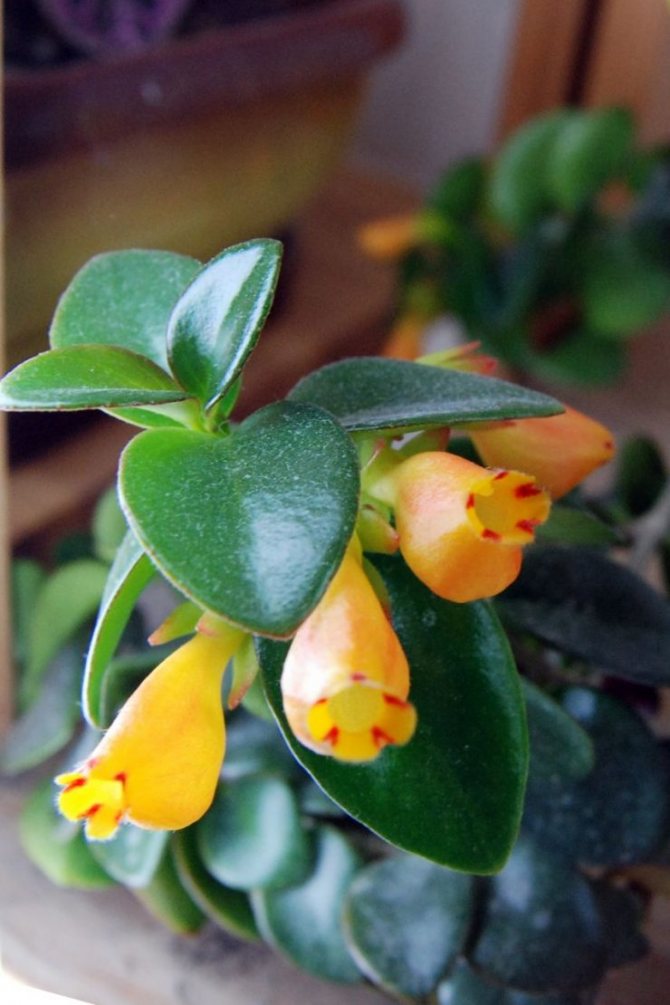

Transfer after purchase
It is not worth replanting the flower immediately after purchase. For a young plant, transplants are performed once a year. For an adult - as the space in the pot decreases. The pot should not be much larger than the previous one. The fact is that in an excessively large capacity, the roots can rot. To prevent stagnation of moisture, provide high-quality drainage.
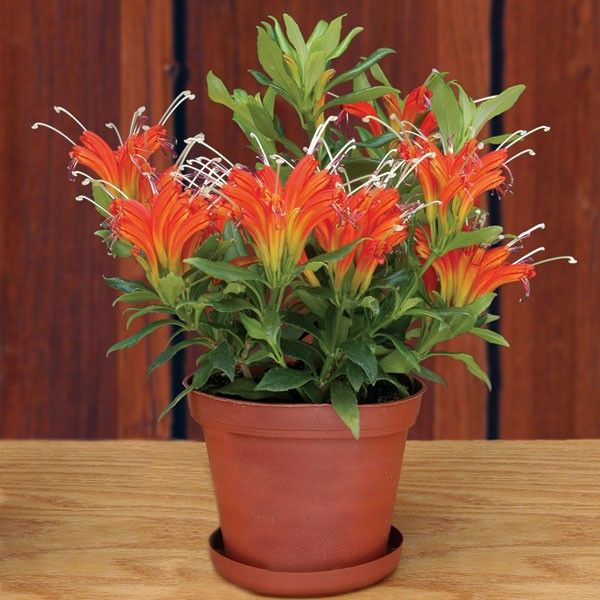

If the pot is too large, the plant will not bloom.
Signs and superstitions


Photo of nematanthus in a pot
One of the plants with which superstitions are associated. It is believed that the flower is favorably kept in the house: it brings happiness and luck to its owners, and attracts financial success.During flowering, nematanthus cheers up, delighting with a school of "goldfish" adorning the dark emerald shining shoots.
Possible growing problems
Growing a flower can be challenging.
Dropping leaves and buds
This problem often occurs in cold weather. The fact is that the plant has an excess of moisture. To eliminate the problem, the nematanthus needs a transplant and correction of watering.
Dry tips
Too much sun hits the flower. To fix the problem, they put it in the shade.
Other problems
Brown spots may be observed on the leaves of the plant. They are the result of burns when spraying in the light. It is recommended to remove the flower in a darker place.
If the plant withers, the roots are likely burned from overfeeding. It is necessary to rinse and dry them. After that, the plant is transplanted.
In the event of an attack by a spider mite, scale insect, aphid or whitefly, the flower is treated with preparations with insecticides.
Nematantus is an exotic plant that will become a worthy decoration for any interior. It will cheer you up and can be presented as a gift. If you take proper care of the plant, the nematanthus will delight with a long and unusual flowering.
Nematanthus longipes
Climbing shrub with leaves uncharacteristically large for nematanthus. They are smooth, light green in color.
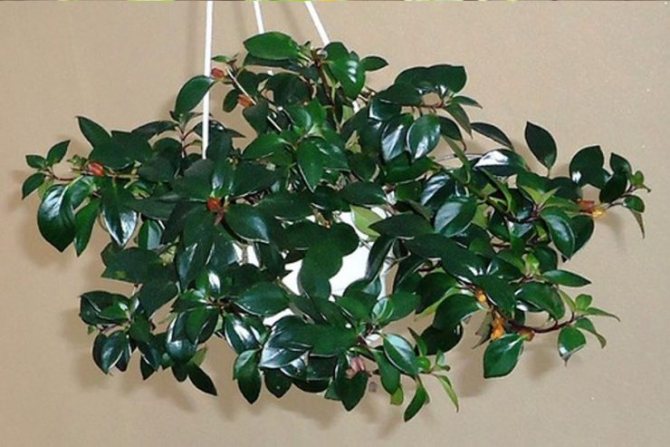

Flowers are singly arranged on pedicels. They are scarlet red in color and funnel-shaped with a slight swelling on the side.
How to properly care for this golden exotic
- Lighting. Like all Tropicans, the goldfish likes to be on the east or west windowsill, where diffused bright light reigns. In winter, it should be placed closer to the lamp, since the flower needs 12 light hours a day.
- Temperature. In winter, 16 degrees is enough for the flower (but the air can be a little colder - but not lower than 12 degrees). In the spring and summer, keep the room around 22.
- Air humidity. On the one hand, the air must be humid, on the other hand, the "plastic" leaves do not like spraying. You have two options: either keep the pot on a pallet with expanded clay poured with water, or spray daily not the flower itself, but the air around it.
- Watering. Pour the settled water into the ground when its upper part dries out.
- Food. In spring and summer, twice a month, you can pamper this flower with a universal mineral fertilizer. But nematanthus is not gluttonous, so when spreading top dressing, pour in water twice as much as the norm indicated on the bag.
- Diseases. The most powerful enemy of a plant is stagnant water, overflows and moisture on the leaves (so water it with extreme caution). Due to excess moisture, the flower can get sick with rot or fungus. These misfortunes are treated with fungicides. But before applying the medicine, all the affected parts must be cut off (the flower is also dug up, because the roots also rot, and they need to be cut off the rot even stronger than the leaves).
- Pests. When buying from a store, take a very good look at the plant. If the seller or the greenhouse was unscrupulous, the flower can be infested with a great variety of insects: thrips, mealybugs, spider mites, aphids. It is better not to buy such a plant than to treat it for a long time.
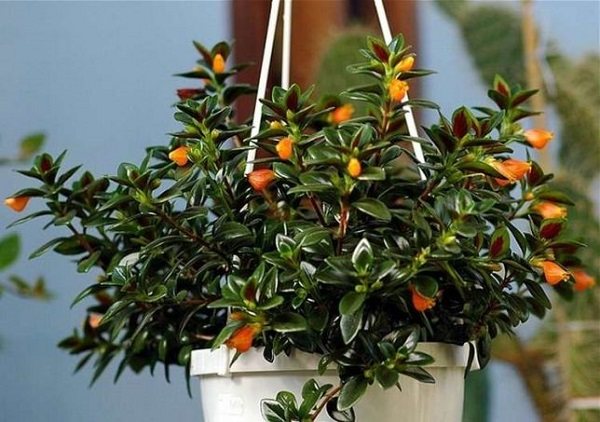

Special growing conditions
- Peace. In winter, the flower needs to be allowed to rest. Move it to a cool room (at the same higher designated 16 degrees). At the same time, the air can no longer be humidified, watering the flower is rare, but the amount of light should still be the same west-east. Reduce the temperature gradually, a sharp drop in temperature can provoke stress. The "wintering" time is from 2 to 2.5 months.
This procedure is very important for a flower: in a cold room, it actively lays flower buds.If the nematanthus spends the winter in a warm place, it will bloom much less, or even declare a "flower boycott" for you for the whole year.
- Pruning. This procedure is carried out at the end of autumn, before transferring the flower to a cold room. You don't have such a room, and your plant will be forced to winter in a warm apartment? So prune it in the spring. In any case, you need to remove weak, thin twigs. This procedure will help the bush to become lush, more beautiful, and healthier too.
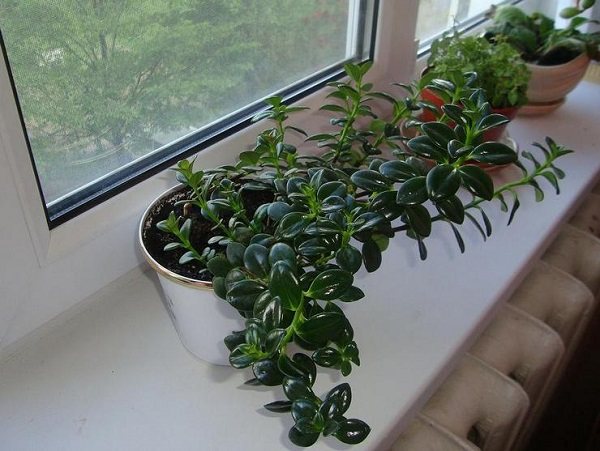

Flower transplant
Like other tropical exotic species, hypocyrtes are transplanted based on their age. Before the flowerpot "knocks" 4 years, it should be replanted annually, in the spring. A more mature plant is disturbed by transplanting a year after a year.
- Priming. If you have no time to compose something of your own, you can buy soil for violets. But if you are a perfectionist, mix: 2 parts each of leafy earth and peat, 1 part each of humus and sand, fluff this mixture with perlite (vermiculite) and / or sphagnum. Also useful here will be coconut fiber (it is airy and nutritious), charcoal (mold protection).
- Pot. May be cramped (in this case, the plant blooms even better). Be sure to place more drainage on the bottom.
Each new pot should be 2 cm wider and deeper than the previous one.
Transplanting should always be done using the transhipment method. At the end, the plant can be watered.


Reproduction of hypocyrtes
- Seeds. They are so small that they cannot be buried in the ground - just scatter them over wet soil, covered with glass. If you water them (only through a pallet, you don't even need to spray the soil) and air them, after 10-14 days you will already have full-fledged sprouts ready for picking. These plants will bloom in a year.
- Cuttings (apical or stem). Cut off the old (!) Twig by 10 cm. It should have about 4 internodes. You can put the stalk in a glass of water, deepen it into the ground, or just wet peat (there should be a knot inside - it is he who gives the roots). Keep it warm for up to 3 weeks, preferably in a greenhouse. After that, it can be transplanted into a small one, and after a year - into a large pot.
But are the other owners of such a goldfish happy? I suggest you find out first-hand by watching this video review. The woman not only shares her impressions of the flower, but also gives advice to beginners:
And this is the professional channel of the plant scientist, and only recommendations sound in it. Want to buy nematanthus? Don't miss this video too:
Some interesting facts
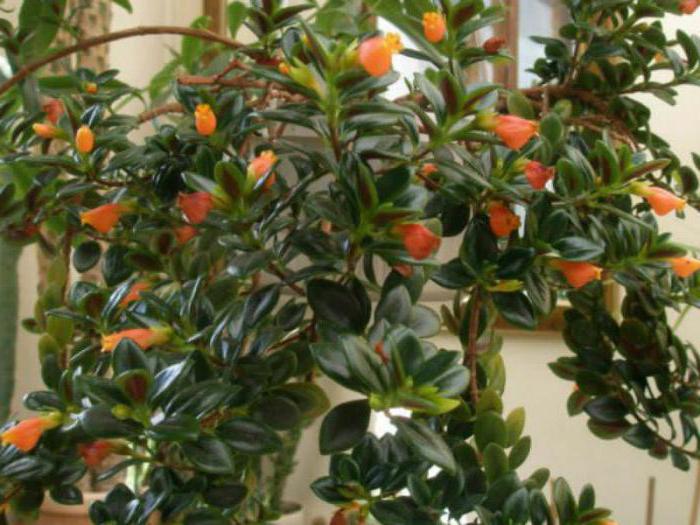

There are various beliefs and legends about many plants among the people, and nematanthus is no exception. If you believe the beliefs, then in the house in which this amazing flower grows, happiness and family idyll will always reign, and its inhabitants will be successful in all endeavors. In addition, the plant purifies the air and serves as an excellent interior decoration. With the right care, the flower will always look amazing, and it will also give people a good mood. Due to their exoticism, Nematanthuses are able to add a slight touch of tropical forests to the decor and make the room brighter, more colorful, interesting and cheerful.
As you can see, it is quite possible to grow nematanthus at home. The most important thing is to adhere to certain tips and recommendations, as well as to provide the flower with proper care.
Watering recommendations
As for watering, you shouldn't do it too often. The signal for watering is the drying out of the soil in the pot. The water must first be defended so that it warms up to room temperature. A sign of a lack of moisture is the curling and falling of the leaves. If this begins to happen, then the Nematanthus flower is immersed in a container of water so that the water does not overflow into the pot. Thus, the plant itself will take as much water as it needs through the drain holes at the bottom of the pot.As soon as the earth is moistened, the plant is taken out of the water, covered with polyethylene and left in this form until the flower regains its attractiveness. When watering, do not overfill the nematanthus, as this can cause root rot and the death of the flower.
Top dressing
It is necessary to use fertilizers in accordance with the stages of flower development. In winter, during the dormant period, the nematanthus is not fed.


In the remaining time, especially during the flowering period, the plant needs quite frequent feeding, using a universal mineral fertilizer.
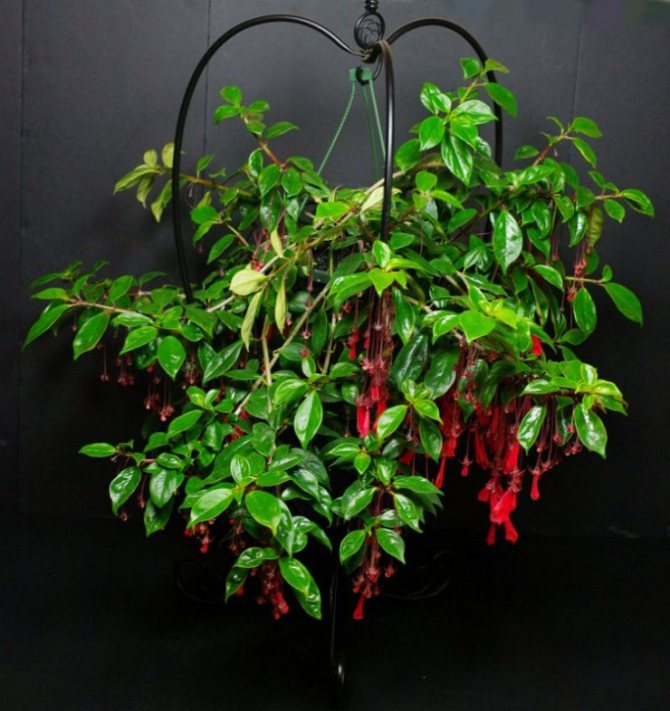

Plant pruning
Nematantus needs a formative pruning at least once a year at the end of the active flowering period, that is, in October. It is necessary to carry out pruning as soon as the shedding of leaves is indicated.
The pruning method is very simple: the shoots of old bushes are shortened by half the length, the branches of young bushes are cut by one third.
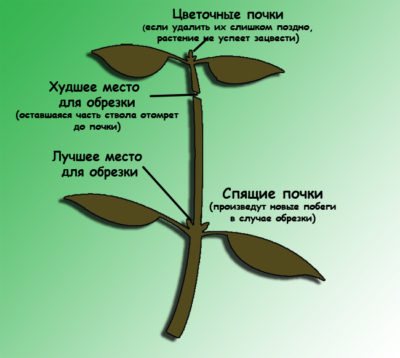

Nematanthus, like other types of houseplants, must be pruned correctly.
Without annual pruning, the plants will lose the density of foliage the next year, the crown will lose its density, the showiness of the silhouette.
It is necessary to shorten the old branches of the nematantus so that they start up new shoots - only they bloom the brightest and largest flowers of this plant. There are few flowers on last year's old branches, they are small and ugly.
Fresh entries Do-it-yourself summer kitchen in the country house: how to build it yourself + design examples Do-it-yourself forged fences: how to make a fence with forging elements?
Briefly about the types of room hypocyrt
In indoor floriculture, two types are most often found:
- Hypocyrta is naked;
- Coin hypocyrt.
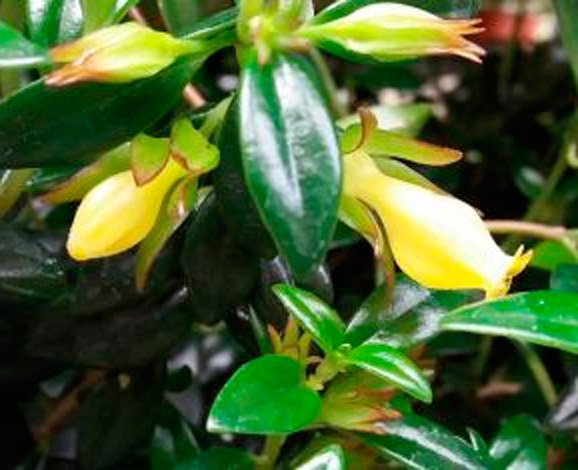

Their main difference lies in the structure of the leaves. The first type has smooth leaves, slightly elongated and waxy luster. While the second type is characterized by pubescent leaves of a more rounded shape. Also, both species have slight differences in the structure of flowers.
Less common types of room hypocyrt include:
- Tropicana;
- Gregarius;
- Golumney;
- Variegated.
The care and cultivation of hypocyrt does not depend on the species to which the plant belongs.
Possible problems and their elimination
- Brown spots on the leaves - watering with cold water or insect damage.
- Hypocyrta does not bloom - there can be many reasons. Pruning was not carried out, due to which young shoots did not grow, too poor soil, lack of light, lack of a dormant period.
- Buds and leaves fall - the specimen is flooded against the background of the cold visiting air. Not to be confused with leaf fall before dormancy in pubescent varieties!
- The leaves turn yellow and bend - too active exposure to sunlight, you need to make the light diffuse, for example, stick tracing paper on the window.
general information
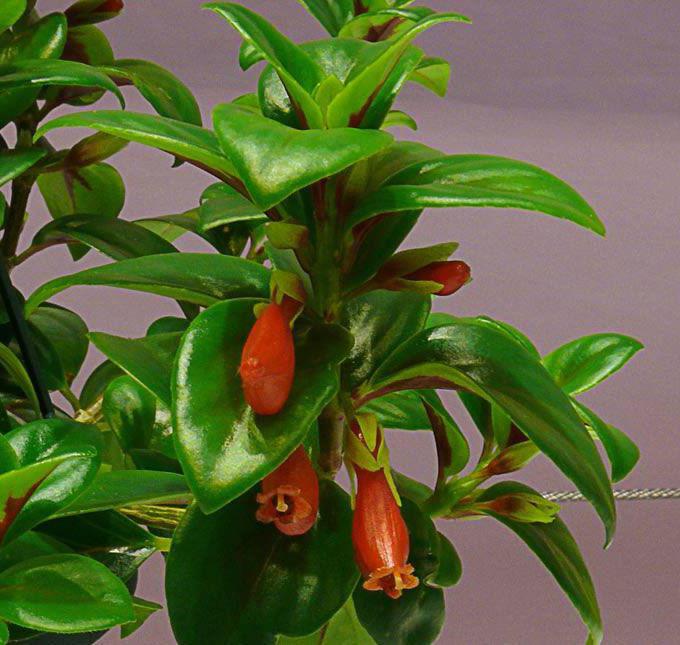

The genus Nematantus includes semi-handicraft and artisanal plants, native to Brazil. But these days, these flowers can be found almost throughout the continent. Its leaves are elliptical, small in size and dark green in color. The stems are straight and very thin, so as the plant grows, they bend under the weight of the flower. The flower stalks are tubular in shape and can reach a length of about 5 centimeters. The corolla of a nematanthus (can it be kept at home and how to properly care for it will be described later) can be red, pink, yellow or purple. The flowering period is quite long and lasts from spring to autumn. In indoor conditions, the flower is grown, as a rule, in various decorative vessels and hanging baskets.
Solarium lover
Hypocirta, although it came out of the shadows of the Amazon and other jungles, is not averse to soak up the sunlight. In a cultural environment, he does not like shading, and from this it will not bloom, but direct rays should be avoided in the garden. Burns may appear on the leaves and the shine will be lost.
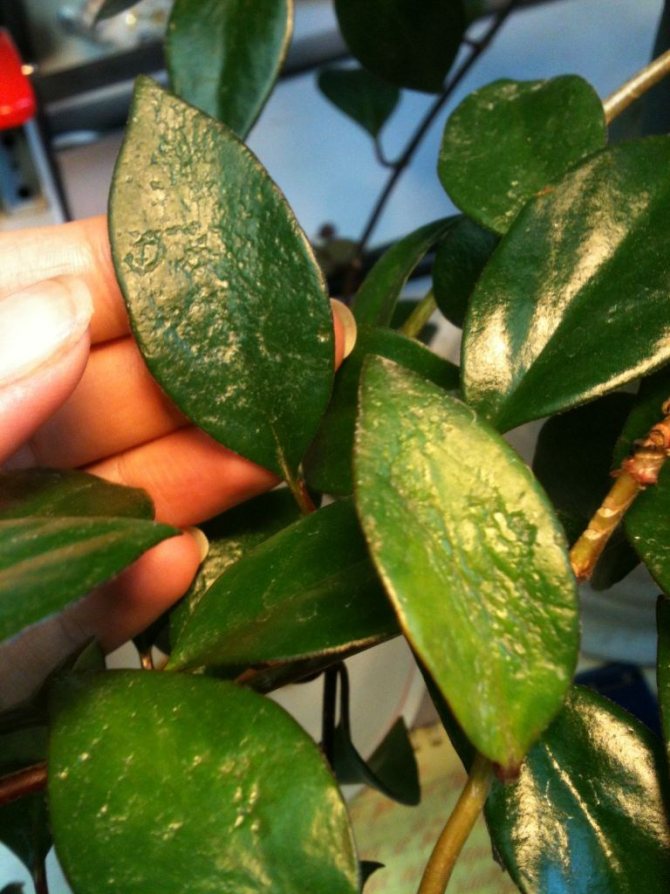

Indoor hypocyrt loves abundant lighting in winter, but it should not be kept near heating sources in the room. The air should not be warmed up more than 12-16 degrees Celsius. In October-February - minimum watering. In the summer - additional irrigation of the bush with a spray gun.
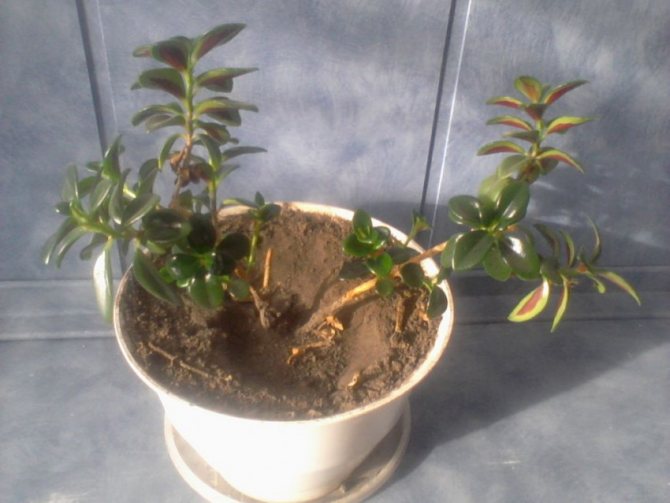

Can I grow outdoors?
You can grow a naked hypocyrt on the street... Plant her in an open area only if there is no frost. It is best to do this in late May or early June. Choose a shaded place. Planting with ready-made seedlings. Maintain a distance of 40-50 cm between plants. The soil should be loose and nutritious, and if it is heavy, sand can be added.
When growing a plant outdoors, the following problems may arise:
- Leaves may turn yellow in mid-summer. There are two reasons: the influence of sunlight or excess fertilizer.
- Brown spots on the leaf blade result from irregular watering or from the use of cold water.
- Lack of flowering remains the most common problem. This occurs for several reasons: lack of light, dense ground, lack of power, lack of pruning.
In addition, the following pests can affect the plant:
- Aphid... It is a green or brown insect that eats a leaf blade.
- Spider mite... The main symptom of its appearance is the presence of a cobweb on the inside of the leaf plate. At the same time, she herself begins to turn yellow.
- Whitefly... The main sign is the presence of small flying white midges.
Hypocyrta coin
The "currency" flower grows naturally in a number of countries between two oceans; it is more petite. Flowers from bright red to yellow with an almost sooty pharynx. In an apartment or a garden, only after heavy rains can you see the swollen cheeks of a flower that has drunk in store of moisture.


This plant is deciduous after flowering. And many amateur flower growers forget this physiological phenomenon of the coin hypocyrt, and often throw it away as an unnecessary plant. But the flower will soon come to life, gaining strength for new branching and flowering.


Benefit and harm
Every housewife can afford a beautiful nematanthus flower. Besides beauty, the plant has a positive effect on the room in which it is located:
- cleans the air from harmful substances;
- attracts good luck to his master's house.
Studies have even been conducted according to which nematanthus improves the well-being of people who are with him in the same room.
Nematanthus (hypocyrta) is one of the few plants that combines the beauty of both leaves and flowers. Therefore, if you have free time, it becomes a great pleasure to grow it at home.
Cultivation and reproduction of hypocyrtes
What time of year is it better to start cultivation?
In the spring, after a dormant period, the nematanthus begins to grow and prepares to bloom. This is the most optimal time for a transplant.
Since the plant is thermophilic, especially during the flowering period, but is afraid of drought and extreme heat, it is not very wise to put it outside. It will be problematic to create favorable conditions for the development of this flower in the open field, especially in our "non-tropical" conditions.
The most optimal place is a glazed balcony or a bright veranda in summer, places that are well ventilated. In winter, if the room is not heated, the flower is brought home.
How to prepare the soil?
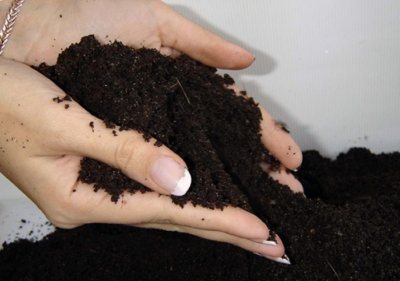

The plant is planted in loose soil. For planting, you can use a ready-made substrate for Saintpaulias or prepare the mixture yourself. To do this, you need to combine peat, humus, sand in equal proportions. Can be added to substrate:
- charcoal;
- sphagnum;
- pine bark.
Don't forget to create good drainage for the plant.
Methods
Seeds
Advantages and disadvantages
Growing nematuntus from seeds is a very troublesome business.... The survival rate here also suffers. The only plus is the ability to get a certain plant variety.
How to choose and prepare material?
The seeds of nematanthus are very small, when planting they need to be poured onto paper and sprayed over a previously prepared substrate.
How to sow: step by step instructions
- Fill a container with a drain hole and a tray with peat and sand, moistening the substrate.
- Spread the seeds over the substrate, then cover it with foil, glass or a transparent lid.
- Water through the pallet. Ventilate sometimes.
- When the seeds hatch, you can remove the shelter.
- After two weeks, you can dive.
- Young seedlings are transplanted into pots in several pieces.
Cuttings
Advantages and disadvantages
The grafting procedure is much easier and survival is almost guaranteed.... Moreover, if you are expecting quick results, this method is more suitable for you. This can be done not only in spring, but also, for example, during pruning.
What are the best shoots to choose?
Young green shoots are not used for cuttings, they do not take root well.
It is necessary to cut off adult stems so that there are 4-5 nodes on them, it is possible without inflorescences. Then remove the lower leaves, treat the cut end with phytohormone.
Planting procedure: step by step instructions
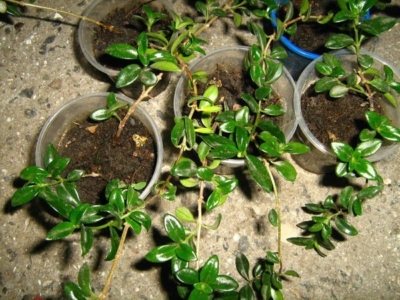

- Pour wet peat with sand into a container in a 1: 1 ratio.
- Root the cuttings so that one node is underground.
- Spray with water and cover with foil.
- Place in a bright and warm place.
- Ventilate and moisturize the cuttings periodically.
- After 2-3 weeks, the rooted cuttings are transplanted into small pots with a diameter of 7-10 cm in several pieces.
Features of work in open ground
In open ground, nematanthus grows only in warm southern countries, from where it originated.
Care
Provide the transplanted plant with bright, diffused light, good watering and feeding at least once a month, and the results will not be long in coming. Cuttings will grow quickly. When planting with seeds, flowering will have to wait a year..
What if it doesn't take root?
If the nematanthus does not bloom for a long time or does not look good, you need to check whether all the conditions of detention, which will be discussed below, are met.
- Is the pot too big for the transplant? The buds are laid in the light, it may be worth rearranging the pot.
- Has the plant been pruned? This guarantees abundant flowering in the next season, as flowers only form on young shoots. You can prune nematanthus in the fall after flowering and sometimes in the spring.
Infrequent transplant, small pot
Nematanthus does not grow very quickly, in this it also looks like a succulent. It builds up the aboveground part rather slowly and the underground part even more slowly. Therefore, the plant does not need frequent transplantation. Even young nematanthuses are transplanted, or rather transplanted, every 2-3 years. By the way, a cramped pot is an incentive for the formation of buds. The flower will signal that it is time to start the transplant itself. Growth from above will be more modest and roots will appear in the drainage holes. As a rule, the procedure is carried out in early spring, when the plant is just starting to grow.
The new container for nematanthus should not be too spacious, only 2-3 cm larger than the old one. Otherwise, it will not bloom. In addition, a large pot increases the risk of putrefactive diseases. In a large volume of land, moisture stagnates longer, parasites settle. And the very delicate root of the nematanthus can get sick.
Prepare the soil for nematanthus loose and airy, slightly acidic or neutral. Approximate composition options:
- ready-made soil for Saintpaulias;
- leafy earth, peat and sand in equal proportions, add chopped pine bark or chopped moss for looseness;
- a mixture of two shares of leafy earth and one at a time - humus, peat and sand with the addition of charcoal crumbs.
High-quality drainage is required for nematanthus (expanded clay, brick chips, vermiculite, pebbles), it will help prevent stagnation of moisture at the roots. How to transplant a fish plant?
- Take a suitable container with large holes, place a drainage layer on the bottom. Everything must be disinfected, boiled, or at least doused with boiling water.
- Spread the sterilized primer on top. Don't tamp it too hard, it should keep it airy.
- Remove the nematanthus from the old pot, being careful to keep the earthy ball. Handle roots very carefully.
- Protect healthy roots, even small ones, from injury, they do not need to be pruned. The root system of the nematanthus grows slowly.
- Place the earthen nematanthus ball in a new pot. Sprinkle the earth. Lightly tamp the substrate at the roots. Leave the soil loose.
- After transplanting, water the plant with warm water, you can spray it.
- Place the transplanted nematanthus in its permanent location.
For information on how to properly root a hypocyrte stalk and control its survival rate, read the chapter "Reproduction of a fish plant".

